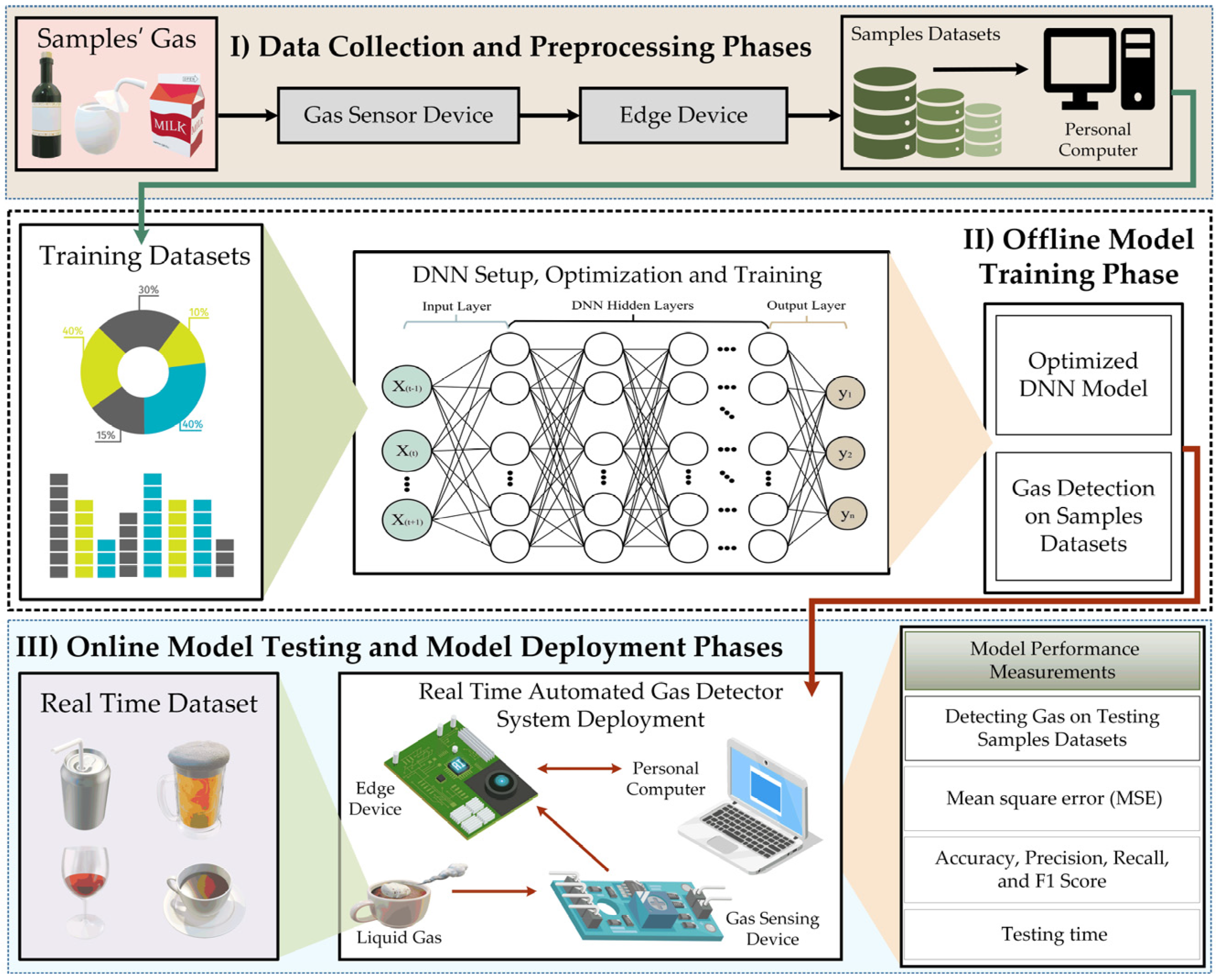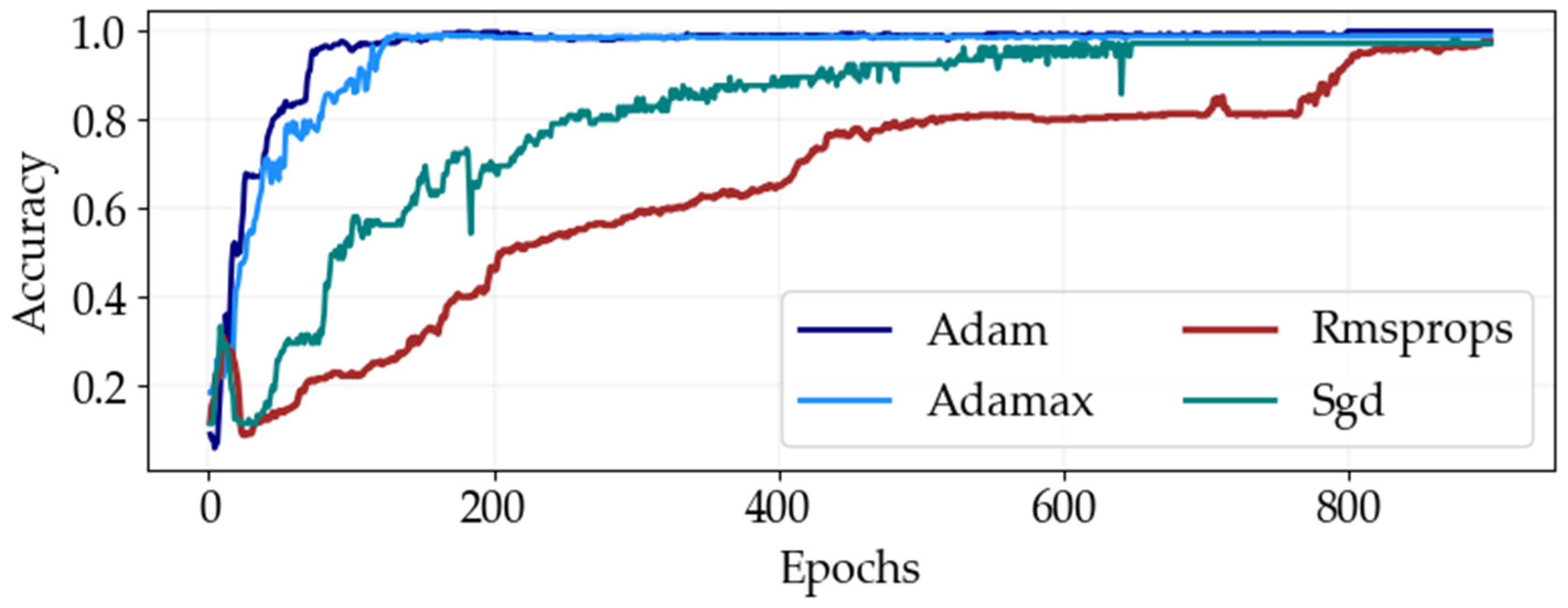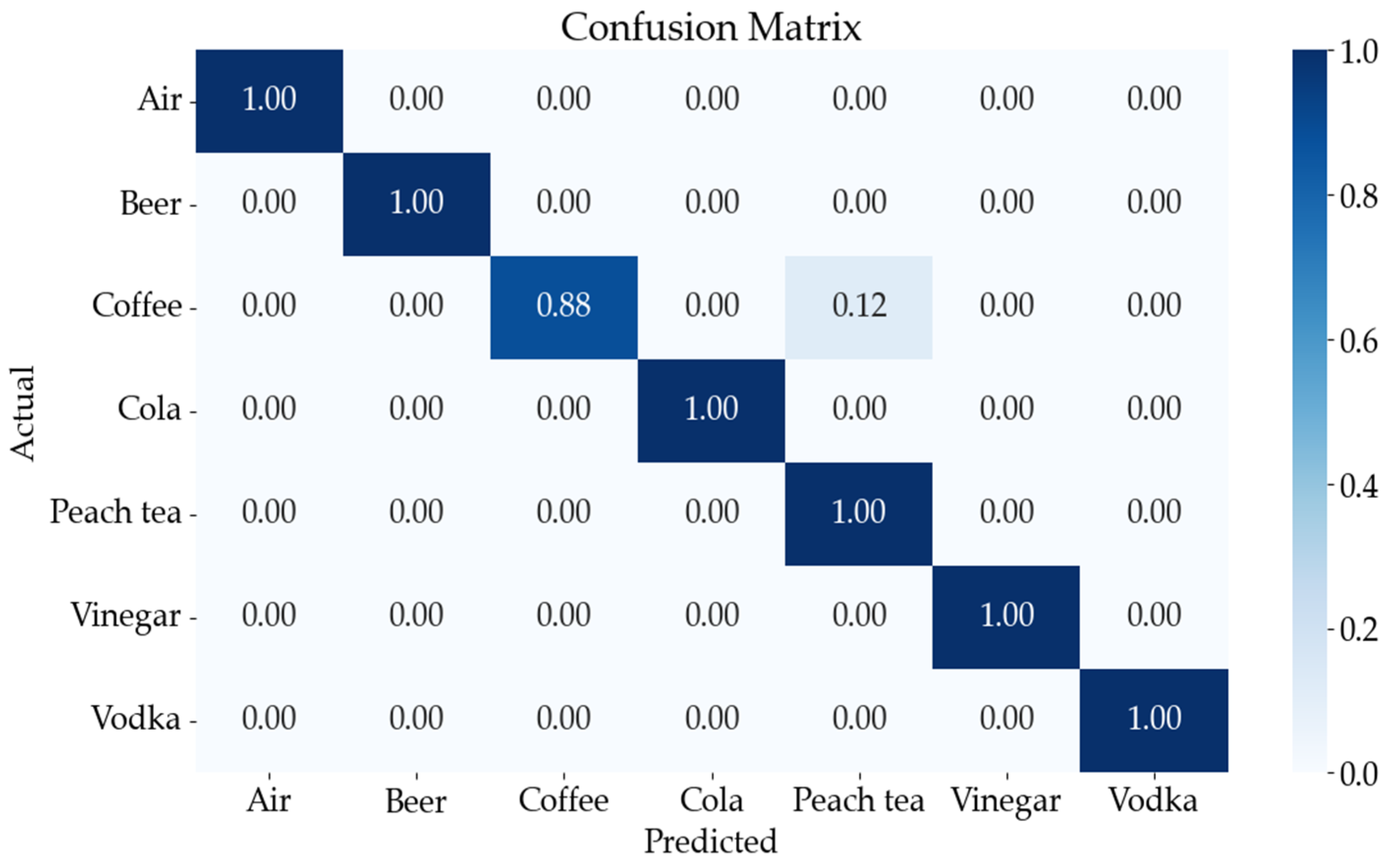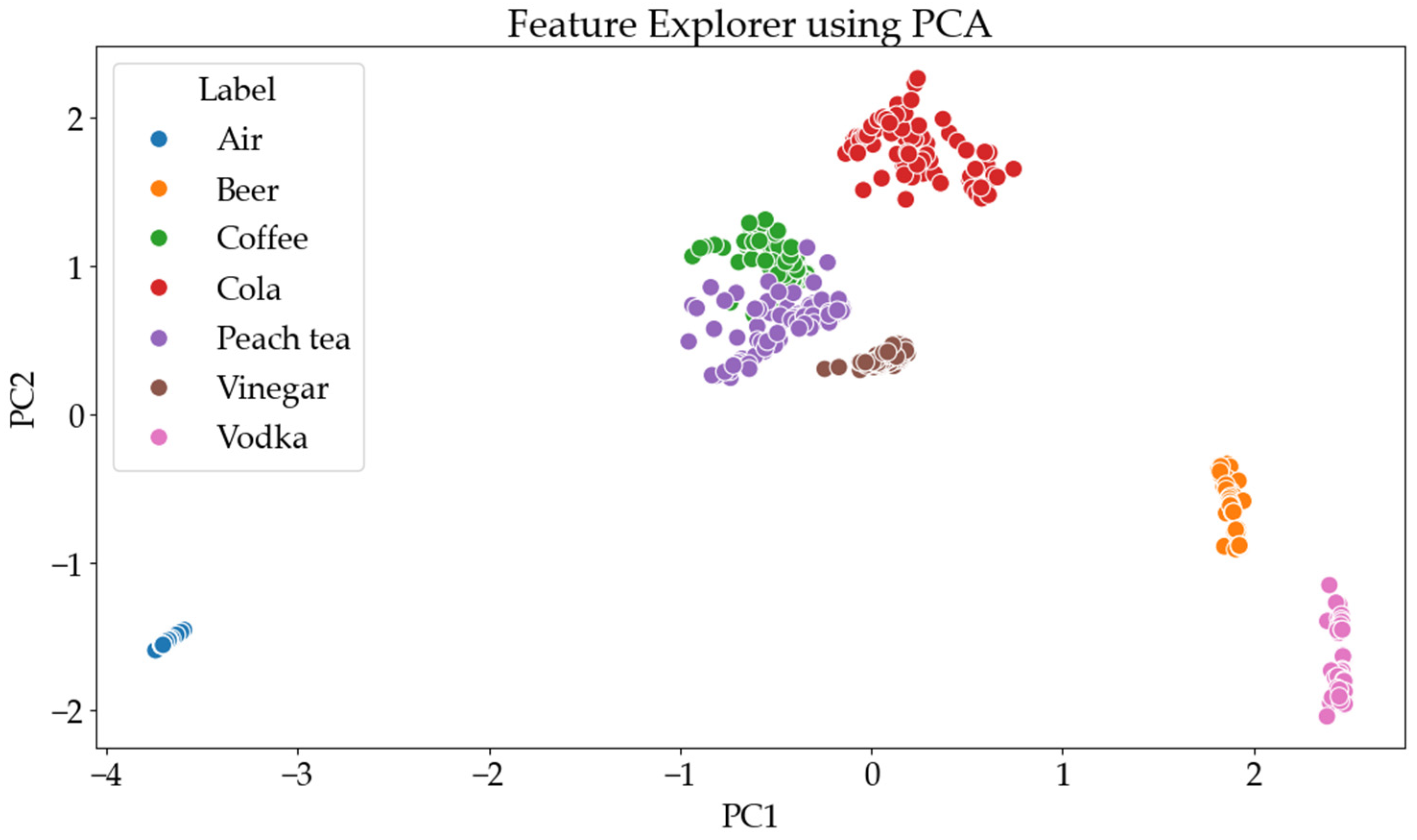Deep Neural Network Optimization for Efficient Gas Detection Systems in Edge Intelligence Environments
Abstract
1. Introduction
- This paper introduces a novel and robust optimized DL framework for efficient gas detection in various applications, including identifying intoxicated drivers in transportation and classifying gases in beverages in industrial applications without human intervention;
- The proposed DNN algorithm is implemented, trained, and optimized on a high-performance personal computer system equipped with graphics processing unit (GPU) computing. To validate the performance, the optimized model is tested on a high-performance personal computer system using new, unseen testing datasets;
- The proposed optimized DNN model system is designed with a modular architecture that allows for easy integration with various gas sensors and edge device platforms. This scalable design supports a range of applications, including detecting intoxicated drivers in transportation and classifying gases in beverages in industrial settings, all without human intervention;
- The proposed system demonstrates the contactless detection capability of the proposed system and eliminates the need for physical contact with the beverage, reducing the risk of contamination and increasing the system’s reliability and durability while also reducing maintenance costs and downtime.
2. Optimized DNN-Enabled Edge Intelligence Gas Detection Experimental Framework
2.1. The Proposed DNN Algorithm Overall System Structure, Optimization, and Training Procedure for Gas Detection Applications
3. Methodology
3.1. Overview
3.2. Data Collection and Pre-Processing
3.3. Deep Neural Network (DNN) Structure
3.4. Hyperparameters Tuning and DNN Algorithm Offline Training to Select Optimal Parameters
4. Results and Discussion
4.1. Results of the Proposed DNN
4.2. Performance Evaluation Metrics of the Proposed DNN
5. Conclusions
Author Contributions
Funding
Data Availability Statement
Conflicts of Interest
References
- Bzai, J.; Alam, F.; Dhafer, A.; Bojović, M.; Altowaijri, S.M.; Niazi, I.K.; Mehmood, R. Machine Learning-Enabled Internet of Things (IoT): Data, Applications, and Industry Perspective. Electronics 2022, 11, 2676. [Google Scholar] [CrossRef]
- Lakshmanna, K.; Kaluri, R.; Gundluru, N.; Alzamil, Z.S.; Rajput, D.S.; Khan, A.A.; Haq, M.A.; Alhussen, A. A Review on Deep Learning Techniques for IoT Data. Electronics 2022, 11, 1604. [Google Scholar] [CrossRef]
- Alajlan, N.N.; Ibrahim, D.M. TinyML: Enabling of Inference Deep Learning Models on Ultra-Low-Power IoT Edge Devices for AI Applications. Micromachines 2022, 13, 851. [Google Scholar] [CrossRef] [PubMed]
- Lee, H.; Lee, N.; Lee, S. A Method of Deep Learning Model Optimization for Image Classification on Edge Device. Sensors 2022, 22, 7344. [Google Scholar] [CrossRef] [PubMed]
- Shah, S.K.; Tariq, Z.; Lee, J.; Lee, Y. Event-Driven Deep Learning for Edge Intelligence (EDL-EI). Sensors 2021, 21, 6023. [Google Scholar] [CrossRef]
- Grzesik, P.; Mrozek, D. Combining Machine Learning and Edge Computing: Opportunities, Challenges, Platforms, Frameworks, and Use Cases. Electronics 2024, 13, 640. [Google Scholar] [CrossRef]
- Li, Z.; Li, H.; Meng, L. Model Compression for Deep Neural Networks: A Survey. Computers 2023, 12, 60. [Google Scholar] [CrossRef]
- Potărniche, I.-A.; Saroși, C.; Terebeș, R.M.; Szolga, L.; Gălătuș, R. Classification of Food Additives Using UV Spectroscopy and One-Dimensional Convolutional Neural Network. Sensors 2023, 23, 7517. [Google Scholar] [CrossRef]
- Mezgec, S.; Koroušić Seljak, B. NutriNet: A Deep Learning Food and Drink Image Recognition System for Dietary Assessment. Nutrients 2017, 9, 657. [Google Scholar] [CrossRef]
- Hafiz, R.; Haque, M.R.; Rakshit, A.; Uddin, M.S. Image-based soft drink type classification and dietary assessment system using deep convolutional neural network with transfer learning. J. King Saud Univ.—Comput. Inf. Sci. 2022, 34, 1775–1784. [Google Scholar] [CrossRef]
- Ahmad, Z.; Shahid Khan, A.; Nisar, K.; Haider, I.; Hassan, R.; Haque, M.R.; Tarmizi, S.; Rodrigues, J.J.P.C. Anomaly Detection Using Deep Neural Network for IoT Architecture. Appl. Sci. 2021, 11, 7050. [Google Scholar] [CrossRef]
- Khan, A.S.; Ahmad, Z.; Abdullah, J.; Ahmad, F. A Spectrogram Image-Based Network Anomaly Detection System Using Deep Convolutional Neural Network. IEEE Access 2021, 9, 87079–87093. [Google Scholar] [CrossRef]
- Almaiah, M.A.; Ali, A.; Hajjej, F.; Pasha, M.F.; Alohali, M.A. A Lightweight Hybrid M Privacy Preserving Model for FC-Based Industrial Internet of Medical Things. Sensors 2022, 22, 2112. [Google Scholar] [CrossRef]
- Site, A.; Nurmi, J.; Lohan, E.S. Machine-Learning-Based Diabetes Prediction Using Multisensor Data. IEEE Sens. J. 2023, 23, 28370–28377. [Google Scholar] [CrossRef]
- Wang, S.-H.; Chou, T.-I.; Chiu, S.-W.; Tang, K.-T. Using a Hybrid Deep Neural Network for Gas Classification. IEEE Sens. J. 2021, 21, 6401–6407. [Google Scholar] [CrossRef]
- Oh, J.; Hwang, H.; Nam, Y.; Lee, M.-I.; Lee, M.-J.; Ku, W.; Song, H.-W.; Pouri, S.S.; Lee, J.-O.; An, K.-S.; et al. Machine Learning-Assisted Gas-Specific Fingerprint Detection/Classification Strategy Based on Mutually Interactive Features of Semiconductor Gas Sensor Arrays. Electronics 2022, 11, 3884. [Google Scholar] [CrossRef]
- Tefera, M.A.; Manie, Y.C.; Yao, C.-K.; Fan, T.-P.; Peng, P.-C. Meta-Learning for Boosting the Sensing Quality and Utility of FSO-Based Multichannel FBG Sensor System. IEEE Sens. J. 2023, 23, 31506–31512. [Google Scholar] [CrossRef]
- Dejband, E.; Tan, T.-H.; Yao, C.-K.; Chang, E.-M.; Peng, P.-C. Enhancing Multichannel Fiber Optic Sensing Systems with IFFT-DNN for Remote Water Level Monitoring. Sensors 2024, 24, 4903. [Google Scholar] [CrossRef]
- Dehnaw, A.M.; Manie, Y.C.; Du, L.-Y.; Yao, C.-K.; Li, Y.-L.; Hayle, S.T.; Peng, P.-C. Bidirectional Free Space Optics Communication for Long-Distance Sensor System. J. Light. Technol. 2023, 41, 5870–5878. [Google Scholar] [CrossRef]
- Mehmood, F.; Ahmad, S.; Whangbo, T.K. An Efficient Optimization Technique for Training Deep Neural Networks. Mathematics 2023, 11, 1360. [Google Scholar] [CrossRef]
- Chen, C.-H.; Lai, J.-P.; Chang, Y.-M.; Lai, C.-J.; Pai, P.-F. A Study of Optimization in Deep Neural Networks for Regression. Electronics 2023, 12, 3071. [Google Scholar] [CrossRef]
- Mattoo, F.A.; Nawaz, T.; Saleem, M.M.; Khan, U.S.; Hamza, A. Deep Learning Based Multiresponse Optimization Methodology for Dual-Axis MEMS Accelerometer. Micromachines 2023, 14, 817. [Google Scholar] [CrossRef] [PubMed]
- El Kafhali, S.; Tayebi, M.; Sulimani, H. An Optimized Deep Learning Approach for Detecting Fraudulent Transactions. Information 2024, 15, 227. [Google Scholar] [CrossRef]
- Ray, P.P.; Dash, D.; De, D. Edge computing for Internet of Things: A survey, e-healthcare case study and future direction. J. Netw. Comput. Appl. 2019, 140, 1–22. [Google Scholar] [CrossRef]
- Ooko, S.O.; Mukanyiligira, D.; Munyampundu, J.P.; Nsenga, J. Edge AI-based Respiratory Disease Recognition from Exhaled Breath Signatures. In Proceedings of the 2021 IEEE Jordan International Joint Conference on Electrical Engineering and Information Technology (JEEIT), Amman, Jordan, 16–17 November 2021; pp. 89–94. [Google Scholar]
- Faliagka, E.; Skarmintzos, V.; Panagiotou, C.; Syrimpeis, V.; Antonopoulos, C.P.; Voros, N. Leveraging Edge Computing ML Model Implementation and IoT Paradigm towards Reliable Postoperative Rehabilitation Monitoring. Electronics 2023, 12, 3375. [Google Scholar] [CrossRef]
- Lin, J.; Zhu, L.; Chen, W.-M.; Wang, W.-C.; Han, S. Tiny machine learning: Progress and futures. IEEE Circuits Syst. Mag. 2023, 23, 8–34. [Google Scholar] [CrossRef]
- Rajapakse, V.; Karunanayake, I.; Ahmed, N. Intelligence at the extreme edge: A survey on reformable TinyML. ACM Comput. Surv. 2023, 55, 1–30. [Google Scholar] [CrossRef]
- Schizas, N.; Karras, A.; Karras, C.; Sioutas, S. TinyML for Ultra-Low Power AI and Large Scale IoT Deployments: A Systematic Review. Future Internet 2022, 14, 363. [Google Scholar] [CrossRef]
- Shamim, M.Z.M. TinyML model for classifying hazardous volatile organic compounds using low-power embedded edge sensors: Perfecting factory 5.0 using edge AI. IEEE Sens. Lett. 2022, 6, 2022. [Google Scholar] [CrossRef]
- Hayajneh, A.M.; Hafeez, M.; Zaidi, S.A.R.; McLernon, D. TinyML Empowered Transfer Learning on the Edge. IEEE Open J. Commun. Soc. 2024, 5, 1656–1672. [Google Scholar] [CrossRef]
- Lamaakal, I.; Ouahbi, I.; El Makkaoui, K.; Maleh, Y.; Pławiak, P.; Alblehai, F. A TinyDL Model for Gesture-Based Air Handwriting Arabic Numbers and Simple Arabic Letters Recognition. IEEE Access 2024, 12, 76589–76605. [Google Scholar] [CrossRef]
- Wang, F.; Zhang, M.; Wang, X.; Ma, X.; Liu, J. Deep learning for edge computing applications: A state-of-theart survey. IEEE Access 2020, 8, 58322–58336. [Google Scholar] [CrossRef]
- Mihigo, I.N.; Zennaro, M.; Uwitonze, A.; Rwigema, J.; Rovai, M. On-Device IoT-Based Predictive Maintenance Analytics Model: Comparing TinyLSTM and TinyModel from Edge Impulse. Sensors 2022, 22, 5174. [Google Scholar] [CrossRef]
- Dehnaw, A.M.; Manie, Y.C.; Du, L.-Y.; Yao, C.-K.; Jiang, J.-W.; Liu, B.-X.; Peng, P.-C. Integrated Sensor-Optics Communication System Using Bidirectional Fiber and FSO Channels and Hybrid Deep Learning Techniques. Sensors 2023, 23, 8434. [Google Scholar] [CrossRef] [PubMed]
- Subramanian, M.; Shanmugavadivel, K.; Nandhini, P.S. On fine-tuning deep learning models using transfer learning and hyper-parameters optimization for disease identification in maize leaves. Neural Comput. Appl. 2022, 34, 13951–13968. [Google Scholar] [CrossRef]
- Hafsa, N.; Rushd, S.; Yousuf, H. Comparative Performance of Machine-Learning and Deep-Learning Algorithms in Predicting Gas–Liquid Flow Regimes. Processes 2023, 11, 177. [Google Scholar] [CrossRef]
- Rana, A.; Dhiman, Y.; Anand, R. Cough Detection System using TinyML. In Proceedings of the 2022 International Conference on Computing, Communication and Power Technology (IC3P), Visakhapatnam, India, 7–8 January 2022; pp. 119–122. [Google Scholar]
- Trivedi, K.; Shroff, H. Identification of Deadliest Mosquitoes Using Wing Beats Sound Classification on Tiny Embedded System Using Machine Learning and Edge Impulse Platform. In Proceedings of the 2021 ITU Kaleidoscope: Connecting Physical and Virtual Worlds (ITU K), Geneva, Switzerland, 6–10 December 2021; pp. 1–6. [Google Scholar]
- Rahman, S.; Khan, Y.A.; Pratap Singh, Y.; Ali, S.A.; Wajid, M. TinyML based Classification of Fetal Heart Rate using Mother’s Abdominal ECG Signal. In Proceedings of the 2022 5th International Conference on Multimedia, Signal Processing and Communication Technologies (IMPACT), Aligarh, India, 26–27 November 2022; pp. 1–5. [Google Scholar]
- Diab, M.S.; Rodriguez-Villegas, E. Performance Evaluation of Embedded Image Classification Models Using Edge Impulse for Application on Medical Images. In Proceedings of the 2022 44th Annual International Conference of the IEEE Engineering in Medicine & Biology Society (EMBC), Glasgow, Scotland, UK, 11–15 July 2022; pp. 2639–2642. [Google Scholar]












| Parameters | Selected Optimal Parameters |
|---|---|
| Number of neurons in the input layer | 400 |
| Optimizer | Adam |
| Learning rate | 0.0001 |
| Activation function | ReLU and Tanh |
| Number layers | 5 |
| Epoch size | 900 |
| Batch size | 128 |
| Number of hidden neurons in customized layers | 824, 512, and 256 |
| Different Class | Precision (%) | Recall (%) | F1-Score (%) |
|---|---|---|---|
| Air | 100 | 100 | 100 |
| Beer | 100 | 100 | 100 |
| Coffee | 100 | 88.0 | 93.62 |
| Cola | 100 | 100 | 100 |
| Peach tea | 89.29 | 100 | 94.34 |
| Vinegar | 100 | 100 | 100 |
| Vodka | 100 | 100 | 100 |
| Weighted Average | 98.47 | 98.29 | 98.29 |
| Accuracy | 98.29 | 98.29 | 98.29 |
Disclaimer/Publisher’s Note: The statements, opinions and data contained in all publications are solely those of the individual author(s) and contributor(s) and not of MDPI and/or the editor(s). MDPI and/or the editor(s) disclaim responsibility for any injury to people or property resulting from any ideas, methods, instructions or products referred to in the content. |
© 2024 by the authors. Licensee MDPI, Basel, Switzerland. This article is an open access article distributed under the terms and conditions of the Creative Commons Attribution (CC BY) license (https://creativecommons.org/licenses/by/4.0/).
Share and Cite
Dehnaw, A.M.; Lu, Y.-J.; Shih, J.-H.; Yao, C.-K.; Bitew, M.A.; Peng, P.-C. Deep Neural Network Optimization for Efficient Gas Detection Systems in Edge Intelligence Environments. Processes 2024, 12, 2638. https://doi.org/10.3390/pr12122638
Dehnaw AM, Lu Y-J, Shih J-H, Yao C-K, Bitew MA, Peng P-C. Deep Neural Network Optimization for Efficient Gas Detection Systems in Edge Intelligence Environments. Processes. 2024; 12(12):2638. https://doi.org/10.3390/pr12122638
Chicago/Turabian StyleDehnaw, Amare Mulatie, Ying-Jui Lu, Jiun-Hann Shih, Cheng-Kai Yao, Mekuanint Agegnehu Bitew, and Peng-Chun Peng. 2024. "Deep Neural Network Optimization for Efficient Gas Detection Systems in Edge Intelligence Environments" Processes 12, no. 12: 2638. https://doi.org/10.3390/pr12122638
APA StyleDehnaw, A. M., Lu, Y.-J., Shih, J.-H., Yao, C.-K., Bitew, M. A., & Peng, P.-C. (2024). Deep Neural Network Optimization for Efficient Gas Detection Systems in Edge Intelligence Environments. Processes, 12(12), 2638. https://doi.org/10.3390/pr12122638









